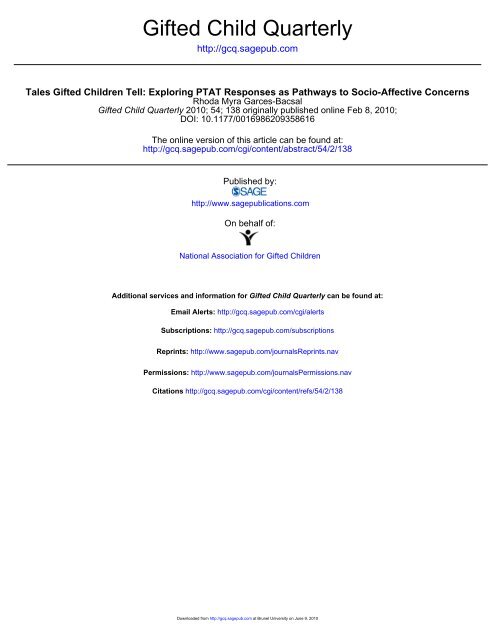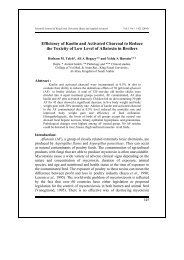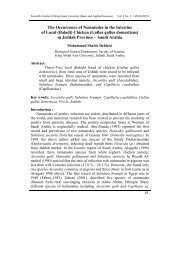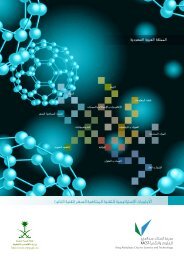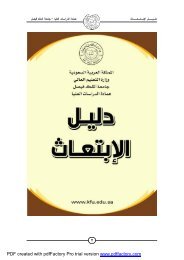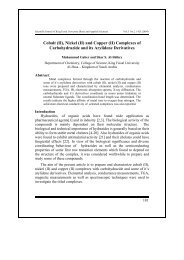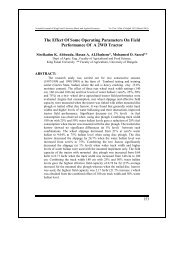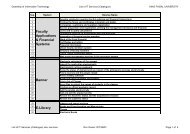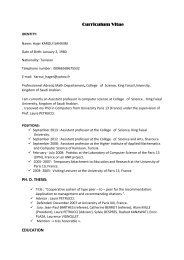Gifted Child Quarterly
Gifted Child Quarterly
Gifted Child Quarterly
Create successful ePaper yourself
Turn your PDF publications into a flip-book with our unique Google optimized e-Paper software.
Garces-Bacsal 139Thus far, studies have primarily focused on Western populations,such as the work done on the social and emotionalissues with exceptionally intellectually gifted students in theAustralian context (Gross, 2002). There have also been studiesfocusing on the impact of racial identity among intellectuallygifted African American learners (Ford, 2002) and the socioculturalcontexts that affect talent development among highabilityHispanic learners (Kloosterman, 1999). The innervoices and experiences of gifted Latino/a adolescents havealso been explored (Shaunessy, McHatton, Hughes, Brice, &Ratliff, 2007). There is paucity in the literature, however, whenit comes to the socio-affective concerns and issues in SoutheastAsian contexts.Robinson et al. (2002) have compiled some of the leadingresearch findings on socio-affective concerns of gifted students.One of their central conclusions in relation to ethnicityis that “gifted students who come from families that differbecause of race, ethnicity, language, socioeconomic status,or a combination of these factors face their own special challenges”(pp. 269-270). The authors recommend that futureresearch on the social and emotional needs of children withhigh potential include the need to prioritize the understandingof the “ways in which demographic and personal variablesinteract with children’s abilities and environments to determinethe patterns of their lives” (p. 284). It is time to heed thevoices of ethnically diverse students, such as the gifted Filipinolearners, as researchers explore the socio-affective concerns ofnon-Western cultures.Quantitative Measures of the Socio-affectiveConcerns of the <strong>Gifted</strong>Two personality tests that are used to get a glimpse of giftedchildren’s inner world are Minnesota Multiphasic PersonalityInventory (MMPI) and 16 Personality Factor (16 PF) Test.The MMPI was administered to gifted adolescents, with amean chronological age of 17 years, by Kennedy (1962),whereas the 16 PF Test was administered to 50 gifted studentsin South Korea, 53 American students in giftedprograms in Florida, 45 gifted students in Finland, and 30students in Slovakia (Shaughnessy et al., 2004). The authorsintended to demonstrate through the pencil-and-paper personalitytests that there are specific personality factors morelikely to characterize gifted children aged 12 years and less(Shaughnessy et al., 2004) as well as among gifted adolescents(Kennedy, 1962).Gross (2004), however, noted the limitations of administeringa pencil-and-paper test to discern gifted children’sperception of self. This was revealed in the Piers–Harris<strong>Child</strong>ren’s Self-Concept Scale where there is an underestimationof the scores of children identified to be gifted.Furthermore, it has been found that the exceptionally highvalue afforded by gifted children on unswerving truth andmorality could also affect their scores on the built-in liescales of various personality tests. This led Gross (2004) tonote that lie scale items on self-esteem inventories or selfconceptscales that deal with questions of ethics or personalmorality “may function differently for exceptionally and profoundlygifted children than for children of average intellectualcapacity” (p. 197).Qualitative Measures of Socio-Affective ConcernsAccording to Sigel (1960), the use of projective tests for personalityresearch with children has grown because they providericher material with which to illustrate the perceptions andinterpretation of children’s realities. Inner thoughts, attitudes,and feelings about the various facets of the child’s world,which would otherwise be unobtainable, are said to be revealedthrough projective measures. Sigel claimed that projectivetests allow the gathering of material that is a reflection of thechild’s inner life—something that has been found to be superiorby most research workers, especially when compared withmore objective methods and observational approaches.Using projective tests as a means to understand gifted childrenis not a new concept and has been used by Louttit (1947)and Smith (1962). However, most of the studies dealt withadolescents (Crespi & Politikos, 2008; Franklin & Cornell,1997; Schaefer, 1970; Smith, 1962) rather than elementaryschool-agedchildren. Louttit’s (1947) review of Ford’sapplication of the Rorschach to 3- to 8-year-old children withIQs of 124 was intended to address the gap in the literatureconcerning the administration of projective tests to youngerchildren. However, in Louttit’s (1947) study, the Rorschachwas administered to obtain normative data based on agegroupsof young subjects and was not intended to illuminatethe gifted children’s socio-emotional concerns.The Rorschach test has also been administered to highabilityadolescent females (Franklin & Cornell, 1997) and tochildren of superior intelligence aged between 11 and 16 years(Gallucci, 1989). The administration of the Rorschach, however,was intended to explore the divergence or originality ofthe gifted adolescents’ responses. Smith (1962) pointed outthat rather than qualitatively looking into emerging themesand patterns evident in the stories in projective measures, theprimary focus of most research is on exploring predefinedthemes such as interpersonal accounts found in the narratives.A further illustration of this would be Schaefer’s (1970)use of the Thematic Apperception Test (TAT) along with personalityand historical data in a study of exceptionally creativeadolescent girls. He analyzed the narratives in light of identityconflicts the teenage girls were experiencing and their strugglesbetween conformity/affiliation and independence. Theseare issues that are believed to be reflective of the developmentalstage that the adolescent girls are in (Schaefer, 1970).The TAT has also been administered to elementary-schoolagechildren (Malgady, Constantino, & Rogler, 1984). Thepsychometric properties of the Tell Me a Story test (TEMAS),Downloaded from http://gcq.sagepub.com at Brunel University on June 9, 2010
140 <strong>Gifted</strong> <strong>Child</strong> <strong>Quarterly</strong> 54(2)a Hispanic version of the TAT—consisting of chromaticstimuli depicting Hispanic characters in urban settings—wasevaluated by Malgady et al. The TEMAS was administeredto 73 low socioeconomic status students in grades K to 6 inpublic schools in New York City. This group was comparedwith 210 Puerto Rican children identified to have clinicalproblems and recruited by teacher referrals in New York Citypublic schools. Malgady et al.’s study was spurred by previousresearch indicating that Hispanic children showed greaterverbal fluency in telling stories about TEMAS pictures whencompared with the TAT pictures. However, the TEMAS wasnot used to demonstrate the predominant socio-affective concernsof the children in the study. Malgady et al. wanted tofurther investigate the psychometric properties of the TEMASto examine its clinical usefulness.Gust (1996) has also advocated the efficacy of the children’sself-report and projective inventory as potential toolsin assessing the emotional and social needs of the gifted agedbetween 5 and 12 years. The self-report consisted of statementsdealing with possible clinical concerns as well asperceived competence. The projective inventory, on theother hand, included instruments such as the kinetic familydrawing, projective story cards, and using colors to depictemotions. Gust reported a case study of a 7-year-old boy anddiscussed how the boy’s responses to the projective instrumentsprovided the author with insight into the child’s socialand emotional world. However, an in-depth analysis of thesocio-affective themes emerging from projective tests wasnot discussed.The use of the TAT as the instrument in discerning thesocio-affective concerns of ethnically diverse and culturallydifferent gifted children in the primary school years is yet tobe explored. The present study aims to address this gap inthe literature and illuminate gifted Filipino students’ socioaffectiveconcerns and “inner life” through a qualitativeanalysis of their narratives in the Philippine adaptation of theThematic Apperception Test (PTAT).Specifically, I examined how gifted Filipino children characterizefamily relationships, school-related concerns, peerissues, and spirituality concerns through the stories that theycreate in the PTAT. I also looked into the differences betweenthe private and public school gifted children’s themes andnarratives. Rather than come up with a predefined templateof socio-affective issues and concerns as is commonly foundin pencil-and-paper tests, I believe that a more groundedanalysis of their stories would be a more subtle and incisivemethodology in discerning their inner affective states.MethodTwenty-two children aged between 4 and 9 years participatedin the study. Eleven children were from the private schoolsetting, and 11 students were from a public school setting.The children were nominated by their teachers (for bothgroups) or by developmental pediatricians (for children fromprivate school settings). Initially, 15 students were nominatedfor the private school group and 21 students for the publicschool group. Purposive sampling was used to get only studentswho obtained a full-scale IQ score of 120 or more(superior category) on the Wechsler Intelligence Scale for<strong>Child</strong>ren–Revised (WISC-R). The objectives of the researchwere detailed in the letter provided to the school principaland the parents to obtain informed consent.Pseudonyms were used to protect the participants’ anonymity(see Table 1). The range of the children’s IQs wasfrom 120 (8-year-old Lenny from the public school setting)to 156 (8-year-old Adrian from the private school group).Table 1 provides details of the names, ages, and IQs of theparticipants.A supervisory team of clinical practitioners and developmentalpsychologists from the University of the Philippinesalso reviewed the research framework and the use of theprojective instrument for ethical viability. The respondents’anonymity was also protected during the entire data collectionprocess; identifying marks were subsequently removed to furtherpreserve the confidentiality of the research proceedings.RespondentsPrivate school respondents. Among respondents from privateschools, four were from big school settings. (A big schoolis operationally defined as a school that has two or moresections per primary level. The school also has more than20 students in a single classroom and has been in existencefor the past 20 years and more.) Seven children were from agifted school setting. (A gifted school is operationally definedas an establishment that specifically claimed to cater to theneeds of gifted and talented children. The school has 7 to 25students per class, with one section per grade level.)Public school respondents. The public school in the study hasbeen in existence since the 1940s in the Quezon City area.The school has a total student population of more than 2,000,from the preschool to the secondary level. On average, therewere eight sections per class in the primary and secondarylevels, with a total of 50 to 60 students per classroom.Measurement InstrumentsThe WISC-R was used as the screening instrument for thisstudy because it is a widely used instrument for the identificationof ethnically different gifted groups (Johnson, 1994)and has also been used to increase the number of underrepresentedminorities for selection in gifted and talented programsin the United States (Masten & Morse, 1995). Saccuzzo,Johnson, and Russell (1992) compared the verbal and performanceIQs of gifted African American, Caucasian, Filipino,and Hispanic children in Grades 1 to 9. Results indicated thatfor Filipino children their Performance IQs (PIQ) were higherDownloaded from http://gcq.sagepub.com at Brunel University on June 9, 2010
Garces-Bacsal 141Table 1. Participants’ Pseudonym, Age, and IQ Test ResultsPrivate School Respondents and Age Full-Scale IQ Public School Respondents and Age Full-Scale IQPink Princess, 4 years, 2 months 135, Very superior Jaycee, 4 years, 8 months 139, Very superiorJM, 5 years, 6 months 134, Very superior Jayjay, 5 years, 6 months 127, SuperiorJaydee, 6 years, 4 months 137, Very superior Ricky, 6 years, 1 month 141, Very superiorKitty, 6 years, 11 months 133, Very superior Katrize, 6 years, 6 months 123, superiorAmelia, 7 years, 7 months 152, Very superior Vic, 7 years, 5 months 128, superiorJP, 7 years, 1 month 134, Very superior Gerald, 7 years, 5 months 133, Very superiorAdrian, 8 years, 3 months 156, Very superior Lynne, 8 years, 4 months 123, superiorYsabella, 8 years, 9 months 130, Very superior Lenny, 8 years, 11 months 120, superiorDonnie, 9 years, 4 months 137, Very superior Frank, 8 years, 11 months 125, superiorGabriella, 9 years, 1 month 134, Very superior Harry, 9 years, 8 months 133, Very superiorJody, 9 years, 5 months 128, Superior Carmina, 9 years, 8 months 127, Superiorthan their Verbal IQs (VIQ). VIQ was also found to be higherthan PIQ for gifted African Americans and Caucasians. Acomparison was also done between WISC-R and WISC-IIIas a screening instrument for potentially gifted children bySevier and Bain (1994). Their findings demonstrate that elementaryschool children being served by specific giftedprograms scored significantly lower on the WISC-III thanon the WISC-R. The implication of this is that a large proportionof gifted students would not have been identifiedand placed in gifted programming if the WISC-III had beenemployed.Philippine Thematic apperception Test. The PTAT, whichwas developed by Lagmay in 1965, is distinct from the TATin using drawings depicting Philippine situations and scenarios.This is significant given the fact that culturally congruentstimuli are said to make the communication of story ideasand themes much easier in the TAT (Teglasi, 1993). Therewere originally 64 cards that were developed and validatedwith students from the University of the Philippines IntegratedSchool (secondary level) for the purpose of comingup with the final set of 25 cards. A second long-range validationstudy was performed including normal and pathologicaland urban and rural respondents of varying ages (Lagmay,1965). Other studies that were performed on the PTATinvolved studying the cards’ ambiguity values and comparingTagalog–English bilinguals’ responses to the cards(Ventura, 1987). A scale for the needs affiliation, power,and achievement was also conducted on the PTAT by Lazoand Ventura (1987).There are 25 black-and-white cards in the PTAT, withCards 1BM, 1GF, 2BM, 2GF, 6G, 6B, and 6FM identified ascards to be administered specifically to either males (M) orfemales (F) or to young girls (G) or young boys (B); Card 13was a blank card. In this study, 22 cards were administered tothe 22 children (Cards 1GF/1BM, 2GF/2BM, 3, 4, 5, 6G/6B,6FM, 7, 8, 9, 10, 11, 12, 13, 14, 15, 16, 17, 18, 19, 20, 21),obtaining a total of 484 stories in all.Procedure for the PTATThe instructions given to the participants during the oneon-onePTAT sessions were very similar to what was foundon the manual, with a few modifications that were deemedessential, such as the reiteration of some test directions,given the age-group of the respondents (see Appendix A forPTAT directions).On average, there were two sessions scheduled for eachof the participants to provide the children greater time toreflect and compose their stories. Test administration for 10PTAT cards ranged from 15 to 41 minutes for the privateschool group and from 18 to 48 minutes among the publicschool group.However, with one particular child, 8-year-old Ysabella,four sessions were needed, given the length and depth ofmost of her responses. Ysabella’s gift is in creative writingand articulated her enjoyment for the task, allowing her tocreate more lengthy responses for each of the cards shown toher. The first five cards administered to her took a total of59 minutes and 37 seconds. Normative data for the TAT suggestedthat stories of 300 words or more were to be anticipatedfrom college students and that children in the first threegrades may produce 60- to 75-word stories (Dana, 1986).Ysabella had 646 words for Card 1 alone. More details of therespondents’ ages and the duration of their PTAT responsesare listed in Table 2.Data AnalysisIn all, 484 stories were generated by the participants (22 cardsfor each of the 22 children). Given the magnitude of the datacollected, I used nVIVO 7.0 for data analysis. Each storywas analyzed for emergent patterns that were slowly generatedthroughout all the children’s narratives. After all the 484stories were studied for recurring themes, a template wascreated to record the citations from each of the children’sDownloaded from http://gcq.sagepub.com at Brunel University on June 9, 2010
142 <strong>Gifted</strong> <strong>Child</strong> <strong>Quarterly</strong> 54(2)Table 2. Respondents and Duration of PTAT NarrativesDuration ofPrivate School Group PTAT Cards (C) Duration of Stories (min:s) Public School Group PTAT Cards (C) Stories (min:s)Pink Princess, 4 C 1-21 27:39 Jaycee, 4 C 1-10 22:01C 11-21 22:52JM, 5 C 1-10 15:11 Jayjay, 5 C 1-21 34:27C 11-21 15:18Jaydee, 6 C 1-10 25:30 Ricky, 6 C 1-10 48:41C 11-21 22:34 C 11-21 23:35Kitty, 6 C 1-10 15:17 Katrize, 6 C 1-10 21:40C 11-21 17:22 C 11-21 46:44Amelia, 7 C 1-10 20:15 Vic, 7 C 1-10 24:17C 11-21 41:44 C 11-21 27:17JP, 7 C 1-19 28:38 Gerald, 7 C 1-10 35:09C 20-21 29:07 C 11-21 26:17Adrian, 8 C 1-10 22:44 Lynne, 8 C 1-10 32:51C 11-21 22:28 C 11-21 29:48Ysabella, 8 C 1-5 59:37 Lenny, 8 C 1-10 25:10C 6-11 58:59 C 11-21 22:48C 12 and 13 22:27 Frank, 8 C 1-10 26:54C 14-17 29:56 C 11-21 18:44C 18-21 23:33 Harry, 9 C 1-10 32:35Donny, 9 C 1-10 26:28 C 11-21 52:01C 11-21 26:55 Carmina, 9 C 1-10 40:18Gabriella, 9 C 1-21 55:45 C 11-21 31:11Jody, 9 C 1-10 37:56C 11-21 27:00Note: PTAT = Philippine Thematic Apperception Test.narratives. A citation refers to a particular story that containsa recurrent theme (e.g., mothers as homemakers). The templateof emergent themes was then used to review and codeall 484 stories. Parameters for each of the themes createdfrom the stories were not standardized, given the qualitativenature and grounded framework of the procedure. This is instark contrast to the traditional self-concept scales where thedomains are clearly delineated from the beginning. Here, thethemes have been generated from the stories themselves andhave been extensively discussed with the person doing theinterrater analysis (see next session).It is to be noted that although there were 49 citations offamilies helping each other, these 49 citations may havecome predominantly from one or two children. Furthermore,not all the 484 stories have families portrayed in them; hence,generating percentages was perceived to be unwise andmight have provided a skewed picture. However, the numericalfigures could assist us in noting trends with regard towhat the children appear to perceive as important. Furthermore,the demographics of the type of children who havehighlighted specific themes were identified. Hence, qualitativecomparisons could be made between private schooland public school children. Possible interpretations as towhy they may perceive this theme to be significant wereexplored and examples of their narratives are portrayed inthis article.The general focus of this article is not so much to come upwith a quantitative account of a largely qualitative procedurebut to develop a grounded analysis based on the children’sown narratives. I also want to demonstrate the intensity andquality of relationships shared among the characters in thePTAT stories and how it links to their socio-affective concernsas gifted children. Beyond the coding and numbers,however, I wanted to highlight the quality and depth of thesharing done by the children through their storytelling. Mostof the stories revealed actual links to their own fields ofexperience: their perceptions on school and education, theirideas regarding family relationships, peer interactions, andspirituality concerns. Through their storytelling, the giftedchildren were able to paint an even substantive and deeperportrait of what their private worlds were like, through thetales they wove.Interrater reliabilityA PhD candidate (Rater B) in clinical psychology consentedto analyze the PTAT narratives of six children (three from theprivate school setting and three from public school setting)
Garces-Bacsal 143for interrater reliability/coding. The six children were selectedwith an eye toward a representation of the following threeage-groups: 4-5, 6-7, and 8-9 years. Two children wereselected from each of the three age-groups: one from a privateschool group and another from the public school setting.Because not all 22 cards could be feasibly analyzed by theperson doing the interrater analysis, 7 PTAT cards werechosen for each of the six children (total of 42 stories) basedon their representativeness with regard to possible storiesthat could be gleaned from them. For a greater descriptionof the 7 chosen cards and the themes commonly foundamong them, see Appendix B. The selection of the 7 representativePTAT cards was approved by the supervisory teamof clinical practitioners who make use of the PTAT in theirown clinical practice.Although Rater B did not exhaustively include all possibleneeds and presses and themes and ending, everything thatshe noted were found in my analysis. I have also listed divergencesand parallelisms among the 42 stories for the 6 children.A major divergence was defined as an analysis that is diametricallyopposed to what the researcher noted down byway of analysis (totally opposite to how the characters arefeeling and thinking and major difference in the interpretationof the narratives). Minor divergence was defined as theanalysis having minor differences by way of wording butessentially and thematically alike. Out of the 42 stories, therewere no indications of a major divergence for themes, needs,presses, and endings. In 39 of the 42 cards, Rater B and I hadidentical interpretations of the story endings as well as citationsfor themes and storylines. The generated themes werediscussed with Rater B.Results and DiscussionThe narrative themes include the following: (a) FamilyRelationships, (b) Perception on School and Intelligence,(c) Predominant Characterization of Heroes, (d) Peer Relationships,and (e) Concerns Related to God and Spirituality.Points of divergence between the private and public schoolstories are explored.It was possible to obtain the exact number of citations pertheme through the use of the qualitative software nVIVO 7.0.These identified themes were grounded on the actual storiescreated by the children. Under the theme of Family Relationships,there were narratives indicating predominantly positivefamily connections. There were also indications of maritaldiscord and problems within the family in their narratives,particularly among children who are coming from singleparenthouseholds. Portrayal of mothers and fathers as wellas the strong presence of extended family and kin were likewiseevident in the tales.The children’s views on school and their thoughts regardingits importance could be gleaned from their stories, and aseparate category was created to document this. Anothermajor category was created to highlight how the childrencharacterize their heroes in their tales, and a separate categoryshowed how the gifted children characterize peer relationshipsin their stories. Although there were themes showinggood belongingness with a peer group, there were also indicationsof peer rejection. The last category pertains to spiritualconcerns as was seen through the gifted children’s stories.Their views about God and about death were evident in thestories they told.Family RelationshipsThe “highest value in Filipino culture” is said to be the importanceplaced on family and kin relationships and is eventouted to be the “core of all social, cultural, and economicactivity” (Quisumbing, 1963, as cited in Church, 1987, p. 276).It is not surprising then that narratives related to the familywas dominant among the 22 gifted respondents. Out of the484 stories, 107 citations were referring to the strong senseof togetherness felt among families in the stories (56 of whichcame from the private school students—showing good representativenessacross private and public school settings).Because most of the narratives focused on family relationships,portrayal of mothers and fathers as well as the strongpresence of extended family (aunts, uncles, grandparents)were discerned in their tales. Table 3 highlights the numberof citations for this category as well as facilitates a comparisonbetween the private and public school groups.In the children’s stories, there were families eating outor having meals together, birthdays being celebrated, andtrips made to the park, among others. There were also indicationsof parent and child reading stories to and playingwith each other, taking family vacations, and giving presentsto each other. One story that would best represent such beautifultogetherness shared from within the family would be afragment of 8-year-old Ysabella’s story in Card 12 (quotedverbatim because the story was narrated in English):Meanwhile, in the fields, while Mr. Gardner was working,Mrs. Gardner stopped to bring him a cold glass ofwater. Since their house was only a short walk awayfrom the fields, Mrs. Gardner didn’t find it hard to takea nice cold glass of water to her husband every afternoon.In the quiet household, while everyone was doingtheir work, Mrs. Gardner after doing her knitting, whenshe finished knitting early, would sit back and relaxwhile reading a book. She thought that if their familycould keep up this nice happy household, they wouldbe able to save some money since the girls were tooold for dolls and other toys, and the little boy Ned, hadalready started Nursery, didn’t want too much toyseither. And Mr. Gardner didn’t need new shirts, theycould save a lot. And maybe buy a better house with abigger barn which would be cement. Everyday, it wasDownloaded from http://gcq.sagepub.com at Brunel University on June 9, 2010
Garces-Bacsal 145were also indications of grandparents who simply doted ontheir grandchildren (as was evident in the private school narratives)as opposed to tales where the family has difficultymaking ends meet (as was shown in the public school stories).There were also citations of aunts and uncles who providedfinancial support for their nieces and nephews (2 in all, comingfrom the public school setting).The very strong sense of family obligation, typical of mostFilipino households, was observed with narratives containing15 citations of children working to help their families financially(14 coming from the public school group). Four-year-oldJaycee from a public school talked about a child protagonistin Card 9 who decided to sell his toys in order to help hisfamily financially. Five-year-old Jayjay told a story about aboy who performed some errands in another house to earn extramoney to give to his parents.Perception on School and IntelligenceThe children’s perception on school and their motivations forstudying hard varied depending on whether they come froma private school setting or a public school setting. In the former,doing their homework seemed to be matter-of-fact and natural.School work appeared to be part of their routine, or simplywhat was expected of them as students. There were no characterswho actively asked them to do their school work;rather, they do it of their own volition. An illustration wouldbe Pink Princess’ story in the Blank Card (13) (story wasrelated in English and copied verbatim):There are four people there because there are two sons,and then there’s a mommy and a daddy. They’re doingtheir chores in the house, because they’re done with theirhomework, the kids are done with their homework(Q: how are they feeling?) they’re very happy. And thenthey rest. Then the kids watch a little TV, then they rest also.For the public school group, the motivation to study was moregoal-directed. The primary objective was to help their familiesin the future either by getting into a good college or transferringto a better school. The pragmatic view of education as a meansto an end—as a means for survival and to make the family’sfinancial state a little better—was keenly evident in thepublic school children’s narratives. For the private schoolgroup, the primary objective was the love for learning.Although there were also goal-directed intentions, it was notso much the responsibility of providing a better future forthe entire family but rather to help society in general or toenrich one’s being in particular. Themes related to schooland intelligence are listed in Table 4.Predominant Characterization of HeroesThere were 117 citations of heroes who were dominant or activelycontrolled their environment through their determinationTable 4. Comparison of Narrative Themes Related to School andIntelligenceThemes Related toTotal No. ofSchool and Intelligence Private Public CitationsImportance of studying hard 7 9 16Education as the key to a better life 0 6 6or desire (65 of these citations came from the private schoolsetting; Table 5).However there were almost an equal number of citationsreferring to submission to natural forces. This may be attributedto the bahala na mentality of most Filipinos, which isloosely translated as fatalism in English. However, as Salazar(1982) pointed out, bahala na does not mean giving up orabsolving one’s self of responsibility through an overrelianceon mysticism. Rather, the person assumes responsibilityfor what is happening and leaves the rest to chance or God.Difference Between Private and Public School HeroesThere were also several dimensions wherein the portrayal ofthe heroes between the public and private school groupsdiverged as seen in the following subthemes.On sensuous impressions. Among the private schoolchildren, their narratives highlighted details about theirsurroundings, the scenery (19 citations), the weather (24),and the comfort afforded by objects (such as their loungingin their own beds or embracing their pillows, 12 citations).The heroes also seemed to take great delight in just takingtime out to smell the flowers, play in the fields, run in thegrass, and bask in the sun—something that was clearlylacking in the public school narratives. An illustration ofsuch a narrative could be found in parts of Ysabella’s storyin Card 13, the blank card (quoted verbatim):So the picture is, there’s a sun here, this is sort of like apoem. The sky is blue, then there’s grass all around withsunflowers all popping out. The poem is . . . the sun isshining warm and bright. It’s so warm it makes me feelas if everything is all right. With the birds chirping andthe wind blowing gently, blowing my hair here and there.The water in the pond is as blue as the sky. The fishes arejumping all around in a circle. The children are playingon the edge of the lake. And since it’s summer they liketo play there all day. The flowers would bloom allaround. There are sunflowers everywhere you look.Their long pretty petals shining like the sun. At night, inthe evening, there’s a cool breeze with the full moonshining down on . . . the moon makes my face look palein the dark, and I see my reflection on the lake.Most of the other narratives indicated a quiet joy in solitude,happiness in relishing one’s meal, or simply gazing out intoDownloaded from http://gcq.sagepub.com at Brunel University on June 9, 2010
146 <strong>Gifted</strong> <strong>Child</strong> <strong>Quarterly</strong> 54(2)Table 5. Predominant Characterization of HeroesNarrative Themes Private School Public School Total No. of CitationsDominant heroes actively controlling the environment 65 52 117Heroes who are meek, passive, and submissive 44 67 111Sensuous impressionsInclusion of details about the scenery 19 0 19Inclusion of details about the weather 24 0 24General degree of comfort (beds, pillows) 12 0 12the open and appreciating the view. For the public schoolgroup, given their strikingly different realities, their concernswere found to be more down to earth and closely related tolife’s basic necessities as could be found in the next subtheme.Degree of comfort versus deprivation. There were strikinglydifferent interpretations on similar cards shown to the childrendepending on their background. A case in point would be thenarratives created by the children in Card 3, which showeda man wearing tattered clothing and slumped on the floor:The man is exercising and feeling tired. He’s practicingto be strong for a sports club ‘cause he wants towin. And he’s ready and soon he is ready to go. Theend is time for baseball. He’s done jogging, racing, theend. (Qfeel): and now he is done in all the sports andhe’s feeling tired again. He’s starting to exercise again,coz he’s a sports man. (6-year-ole Jaydee in Card 3; notranslation needed)One day po, this person po, is having a hard time withhimself and is begging for money so he can eat. But noone was giving him money, so his stomach was aching,and he felt very sad, and he could not do anything withhimself, except cry. The ending po is that he died becausehe had no more food to eat and he was so hungry . . .Maybe when he was a child, he didn’t study hard that’swhy he wasn’t able to get a good job, and that’s whathappened to him. (8-year-ole Frank in Card 3; no translationneeded)As could be clearly seen, the stories were powerful reflectionsof the children’s life experiences and sensitively depicted thesituations they were going through despite their tender ages.It was particularly moving to note the degree of comfort andopportunities provided to the private school children, whichthey take as matter of fact. For the gifted children from thepublic school setting, however, these are mere dreams thatthey wish to attain through education and hard work.Peer RelationshipsThere were 23 citations (17 coming from the private schoolgroup) that indicated a great sense of belongingness withpeers from among the major characters in the story (Table 6).The characterization of time spent with friends as depictedby the private school group differ qualitatively once againwith the public school group. There was a degree of carefreelikeenjoyment of time spent with peers from the privateschool setting, with mention of parks and playgrounds (ascould be found in the narrative of 9-year-old Gabriella inCard 13), playing with balloons (as could be found in thestory of 5-year-old JM), or just happily climbing trees asnoted by Ysabella’s story in Card 19. With the public schoolgroup, Lynne talked about the “stolen time” spent with friends,away from her chores and responsibilities at home.There were also a few references made with regard tocharacters who were teased by their friends (three citations,all coming from the public school setting) and experiences ofbeing bullied by friends or having classmates who were unruly(five citations, again all coming from the public school group).There were also narratives of heroes having no peer groupat all (five citations, two coming from the private schoolgroup). A possible explanation for the larger number of referencesmade to bullies by the public school group is the factthat they are more exposed to greater diversity within theschool and the fact that they have 40 to 65 children inside theclassroom.Concerns Related to God and spiritualityThere were clear references to the supremacy of God’s powerand his omnipotence (see Table 7).For the private school group, Ysabella talked about theconstant presence of God despite our not being able to seeHim as was noted in her story in Card 18: “nobody is watching,but God is always there, and He can see them.” Nine-year-oldJody, on the other hand, talked about God as a creator ofeverything natural “except artificial” in Card 7. There werealso clear references to God helping out those who helpthemselves, particularly those who were asking for forgivenessor redemption from past misdeeds committed. Hence,the perception of a forgiving God who provides solace andcomfort to those who need it was very evident in the narrativesof the gifted children, regardless of whether they comefrom the private or the public school setting.With regard to the gifted children’s conception on death,apart from the strong bereavement felt by characters whosefamily members or close friends died (or the need to avengeDownloaded from http://gcq.sagepub.com at Brunel University on June 9, 2010
Garces-Bacsal 147Table 6. Narrative themes concerning peer interactionsNarrative Themes Private School Public School Total No. of CitationsSense of belongingness with peers 17 6 23Friends providing support 2 7 9Being teased by friends 0 3 3Presence of unruly classmates 0 5 5Having no peer group (friends) 2 3 5Table 7. Narrative Themes Concerning God and Spirituality ConcernsNarrative Themes Private School Public School Total No. CitationsSupremacy of God’s power 4 3 7Forgiving and helpful God 1 1 2Death as a key to afterlife 2 2 4family members who died tragically or unjustly), as well asthe thought of a life after death (seeing family members inheaven), there was only a fleeting mention of how death wasconceptualized. Mostly the ideations were tinged with thesurreal or the magical with the marked presence of angelsor ghosts or family members who had already died. Deathwas generally perceived as a chance to be reunited with departedloved ones. It was assumed that one’s life here was notthe end but a preparation for that which would come in theafter life.Conclusion and RecommendationsThis article was written to expand cross-cultural perspectiveon the socio-affective needs of gifted children from disadvantagedbackgrounds. The primary goal of this article wasto give voice to gifted children who are coming from culturallyand linguistically different realities and allow them toexpress their innermost thoughts and feelings through thestories they tell. It is also meant to promote greater crossculturalawareness of how issues related to socio-emotionaldomains may vary between and within cultures.Since the 1965 Immigration act, 40% of the documentedimmigration to the United States is said to have come fromAsia with the Philippines being the largest source, comprisingnearly a quarter of the total Asian immigration and thesecond largest source of all immigration, next only to Mexico(Espiritu, 2003). Although recent literature addresses crossculturaldifferences (Nokelainen, Tirri, & Campbell, 2004;Rostan, Pariser, & Gruber, 2002) and its impact on parentalinvolvement in the child’s cognitive development and eventualcareer choices (Alva, 1993; Sy, Rowley, & Schulenberg,2007; Tang, 2002; Verna & Campbell, 1998), there is a tendencyto lump all non-Whites together into the Asian orSoutheast Asian or Pacific Islander category (Posadas, 1999),notwithstanding the stark contrasts between these multiplesubgroups, leading most researchers to conclude the necessityfor “ethnic-specific research” (Agbayani-Siewert, 2004;Alva, 1993; Gloria & Ho, 2003; Yang, 2004).Moreover, Filipinos who were initially found to be underrepresentedin gifted programs in the United States are nowbelieved to be overrepresented (Saccuzzo & Johnson, 1995).Looking closely at the data presented by Kitano and Dijosia(2002), which indicated the percentage of district studentscertified as gifted by APA subgroup, there were 306 certifiedFilipino students (out of 1,093 tested) identified to begifted—the largest number when compared with Chinese,Japanese, Asian Indian, Cambodian, and other subgroups.Yet despite the figures, the socio-emotional and learningneeds of gifted Filipino learners are yet to be found in theliterature.The Philippines is a huge country with 7,100 islands. Thenarratives clearly indicated that even among these 22 childrenwho came largely from urban localities (Quezon Cityand Manila), clear diversity could already be discerned onhow they view the world and express their ideas and emotions,depending on which contextual realities they are coming from.What was also striking was the remarkable resilience ofgifted children from public schools who were raised in impoverishedconditions—a reality that was clearly reflected intheir stories. The capacity to transcend one’s present stateand the motivation to strive harder and overcome one’s presentstate through hard work as manifested in “studying hard”and “doing one’s assignments” were recurring themes. Theprivate school children, on the other hand, revealed vividflights of fancy and imagination in their narratives. This is aclear demonstration of their keen appreciation of their surroundings.The importance and salience of family life amongthe gifted Filipino children, regardless of the economic backgroundthey came from, was also prominent. This echoesDownloaded from http://gcq.sagepub.com at Brunel University on June 9, 2010
148 <strong>Gifted</strong> <strong>Child</strong> <strong>Quarterly</strong> 54(2)what has continually been said about Filipino families beingvery closely knit (Dunn, Milgram, & Price, 1993; Wong-Fernandez & Bustos-Orosa, 2007). Because gifted childrenare said to be endowed with overexcitabilities (O’Connor,2002) and heightened multifaceted sensitivities (Mendaglio,2003), this strong sense of family obligation (as well as thestrong presence of extended family), as could be discerned inthe narratives of the gifted children, may be more keenly feltand experienced. Counselors and educators should exercisesensitivity in the manner in which they motivate and nurturetheir gifted students’ talents because their need for achievementmay be linked to a culturally approved need to pleasetheir parents or to make their families proud of them. Thedivergences in the narratives clearly point toward cautionin perceiving children who come from the same ethnicbackground as homogenous. This has clear implications foreducators, counselors, and clinicians who may be dealingwith the Filipino community in their gifted programs.Moreover, the narratives indicated the remarkable abilityof culturally appropriate projective measures such as thePTAT to elicit rich responses and imagery from the giftedchildren who were very candid in their sharing. The use ofsuch instruments as a window to the child’s socio-affectiveconcerns should be considered further by clinicians, practitioners,and counselors.Appendix AInstructions Given for the PTATHello (name). We are now going to do something different. 1This is a test of imagination. I am going to show you somecards, one at a time. Your task is to tell me what the story inthe card is. Tell me what happened before in the picture,describe what is happening at the moment, and what willhappen in the future. So you are to tell me the past, present,and the future of this story. Tell me what the characters in thestory are thinking and feeling and I will type down what yousay. Imagine that I am your secretary and you are the storyteller.There are no right or wrong answers here. So just tellme what your stories are as they come to you.Appendix BDescription of the Seven PTAT Cards for InterraterReliabilityCard 2 shows a picture of an adult and a child—commonly seen as depicting parent–child interactions.Card 6FM shows an image of a young lady and twoyoung men behind her—commonly seen as depictingpeer relationships.Card 7 shows an image of a high-ceilinged infrastructure—commonly seen as a church. This is meant to representthe children’s spirituality issues (thoughts about religionand God).Card 10 shows a picture of a young child sitting onthe lap of an old lady while an old man offers thechild a treat. The shadows of two people (male andfemale) could be seen in the background. This pictureis meant to depict relationships with extendedfamily.Card 12 shows a picture of a nipa hut without any peopleon it, requiring the children to introduce theirown set of characters.Card 13 is the blank card.Card 16 shows a picture of a woman fixing somethingon the bed while a boy plays with something on thefloor—commonly seen as depicting parent–childinteractions.Author’s NoteSpecial thanks to Prof. Maureen Neihart for her valuable feedbackand comments on the initial draft of this paper and to my DissertationSupervisor, Prof. Violeta Bautista for her guidance.Declaration of Conflicting InterestsThe author declared no potential conflicts of interest with respect tothe authorship and/or publication of this article.FundingThe author received no financial support for the research and/orauthorship of this article.Note1. Prior to the administration of the PTAT, the WISC-R was initiallyadministered to the gifted children during a different session/date.ReferencesAbbott, J. A. (1982). An anthropological approach to the identificationof Navajo gifted children. In J. A. Abbot (Ed.), Identifyingand educating the disadvantaged gifted talented (pp. 7-18). LosAngeles: National/State Leadership Training Institute on the<strong>Gifted</strong> and Talented.Agbayani-Siewert, P. (2004). Assumptions of Asian Americansimilarity: The case of Filipino and Chinese American students.Social Work, 49, 39-51.Alva, S. A. (1993). Differential patterns of achievement amongAsian American adolescents. Journal of Youth and Adolescence,22, 407-423.Baldwin, A. Y. (2004). The seven plus story: Developing hiddentalent among students in socioeconomically disadvantaged environments.In A. Y. Baldwin (Ed.), Culturally diverse and underservedpopulations of gifted students (pp. 149-160). ThousandOaks, CA: Corwin Press.Bettelheim, B. (1977). The uses of enchantment: The meaning andimportance of fairy tales. New York: Alfred A. Knopf.Downloaded from http://gcq.sagepub.com at Brunel University on June 9, 2010
Garces-Bacsal 149Borland, J. H., Schnur, R., & Wright, L. (2004). Economically disadvantagedstudents in a school for the academically gifted: Apostpositivist inquiry into individual and family adjustment. InA. Y. Baldwin (Ed.), Culturally diverse and underserved populationsof gifted students (pp. 191-224). Thousand Oaks, CA:Corwin Press.Church, A. T. (1987). Personality research in a non-Western culture:The Philippines. Psychological Bulletin, 102, 272-292.Colangelo, N., Kerr, B., Christensen, P., & Maxey, J. (2004). Acomparison of gifted underachievers and gifted high achievers.In S. M. Moon (Ed.), Social/emotional issues, underachievement,and counseling of gifted and talented students (pp. 119-132).Thousand Oaks, CA: Corwin Press.Cornell, D. G. (2004). High ability students who are unpopularwith their peers. In S. M. Moon (Ed.), Social/emotional issues,underachievement, and counseling of gifted and talented students(pp. 31-42). Thousand Oaks, CA: Corwin Press.Crespi, T. D., & Politikos, N. N. (2008). Personality assessmentwith adolescents: Challenges and guidelines. Adolescence, 43,593-606.Cross, T. L., & Burney, V. H. (2005). High ability, rural and poor:Lessons from Project Aspire and implications for school counsellors.Journal of Secondary <strong>Gifted</strong> Education, 16, 148-156.Dana, R. H. (1986). Thematic apperception test used with adolescents.In A. I. Rabin (Ed.), Projective techniques for adolescentsand children (pp. 14-36). New York: Springer.Dettman, D. F., & Colangelo, N. (2004). A functional model forcounseling parents of gifted students. In S. M. Moon (Ed.),Social/emotional issues, underachievement, and counseling ofgifted and talented students (pp. 213-220). Thousand Oaks, CA:Corwin Press.Dunn, R., Milgram, R. M., & Price, G. E. (1993). Teaching andcounseling gifted and talented adolescents: An internationallearning style perspective. London: Praeger.Espiritu, Y. L. (2003). Home bound: Filipino American lives acrosscultures, communities, and countries. Berkeley: University ofCalifornia Press.Ford, D. Y. (2002). Racial identity among gifted African American students.In M. Neihart, S. M. Reis, N. M. Robinson, & S. M. Moon(Eds.), The social and emotional development of gifted children:What do we know? (pp. 155-164). Waco, TX: Prufrock Press.Franklin, K. W., & Cornell, D. (1997). Rorschach interpretationwith high-ability adolescent females: psychopathology or creativethinking? Journal of Personality Assessment, 68, 184-196.Gallucci, N. T. (1989). Personality assessment with children of superiorintelligence: Divergence versus psychopathology. Journal ofPersonality Assessment, 53, 749-760.Gloria, A. M., & Ho, T. A. (2003). Environmental, social, andpsychological experiences of Asian American undergraduates:Examining issues of academic persistence. Journal of Counselingand Development, 81, 93-106.Gross, M. U. M. (2002). Social and emotional issues for exceptionallyintellectually gifted students. In M. Neihart, S. M. Reis,N. M. Robinson, & S. M. Moon (Eds.), The social and emotionaldevelopment of gifted children: What do we know (pp. 19-30).Waco, TX: Prufrock Press.Gross, M. (2004). Exceptionally gifted children (2nd ed.). New York:Routledge.Gust, K. (1996). Assessing the social and emotional needs of thegifted: using the children’s self-report and projective inventoryas a potential tool. <strong>Gifted</strong> <strong>Child</strong> Today, 19(5), 38-40.Harris, C. R. (1993). Identifying and serving recent immigrant childrenwho are gifted (Report No. EDO-EC-93-3). Washington,DC: Office of Educational Research and Improvement. (ERICDocument Reproduction Service No. ED358676)Hebert, T. (1991). Meeting the affective needs of bright boys throughbibliotherapy. Roeper Review, 13, 207-212.Hebert, T., & Kent, R. (2000). Nurturing social and emotionaldevelopment in gifted teenagers through young adult literature.Roeper Review, 22, 167-171.Johnson, N. (1994). Use of the WISC-R with disadvantaged giftedchildren: Current practice, limitations, and ethical concerns.San Diego, CA: San Diego Unified School District. (ERIC DocumentReproduction Service No. ED368097)Kennedy, W. (1962). MMPI profiles of gifted adolescents. Journalof Clinical Psychology, 18, 148-149.Kitano, M., & Dijosia, M. (2002). Are Asian and Pacific Americansoverrepresented in programs for the gifted. Roeper Review, 24(2), 76.Kloosterman, V. (1999). Socio-cultural contexts for talent development:A qualitative study on high ability, Hispanic, bilingualstudents. Storrs, CT: University of Connecticut. (ERIC DocumentReproduction Service No. ED443214)Lagmay, A. V. (1965). Philippine Thematic Apperception Test.Quezon City: University of the Philippines Press.Lazo, L. S., & Ventura, E. R. (1987). Scaling the PhilippineThematic Apperception Test (PTAT) for needs achievement,affiliation, power. In A. J. Carlota & L. S. Lazo (Eds.), Psychologicalmeasurement in the Philippines: A book of readings(pp. 199-213). Quezon City, Philippines: UP PsychologyFoundation.Louttit, C. M. (1947). The application of the Rorschach test to youngchildren. Journal of Educational Psychology, 38, 190-191.Malgady, R. G., Constantino, G., & Rogler, L. H. (1984). Developmentof a thematic apperception test (TEMAS) for urban Hispanic children.Journal of Consulting and Clinical Psychology, 52, 986-996.Masten, W., & Morse, D. (1995). Factor structure of the WISC-Rfor Mexican-American students referred for intellectually giftedassessment. Roeper Review, 18, 130-131.McBee, M. T. (2006). A descriptive analysis of referral sources forgifted identification screening by race and socioeconomic status.Journal of Secondary <strong>Gifted</strong> Education, 17, 103-111.Mendaglio, S. (2003). Heightened multifaceted sensitivity of giftedstudents: Implications for counseling. Journal of Secondary<strong>Gifted</strong> Education, 14, 72-82.Mitchell, B. (1982). Identification of the gifted and talented: A screeningprocess with special emphasis on the culturally different. In J.Abbott (Ed.), Identifying and educating the disadvantaged giftedDownloaded from http://gcq.sagepub.com at Brunel University on June 9, 2010
150 <strong>Gifted</strong> <strong>Child</strong> <strong>Quarterly</strong> 54(2)talented (pp. 51-61). Los Angeles: National/State LeadershipTraining Institute on the <strong>Gifted</strong> and Talented.Nokelainen, P., Tirri, K., & Campbell, J. R. (2004). Cross-culturalpredictors of mathematical talent and academic productivity.High Ability Studies, 15, 229-242.O’Connor, K. J. (2002). The application of Dabrowski’s theory of thegifted. In M. Neihart, S. M. Reis, N. M. Robinson, & S. M. Moon(Eds.), The social and emotional development of gifted children:What do we know? (pp. 51-60). Waco, TX: Prufrock Press.Olszewski-Kubilius, P. (2002). Parenting practices that promote talentdevelopment, creativity, and optimal adjustment. In M. Neihart,S. M. Reis, N. M. Robinson, & S. M. Moon (Eds.), The social andemotional development of gifted children: What do we know?(pp. 205-212). Waco, TX: Prufrock Press.Pierce, R., Adams, C., Speirs Neumeister, K., Cassady, J., Dixon, F., &Cross, T. (2007). Development of an identification procedure fora large urban school corporation: Identifying culturally diverseand academically gifted elementary students. Roeper Review,29, 113-118.Posadas, B. M. (1999). The Filipino Americans. Westport, CT:Greenwood Press.Raines, S. C., & Isbell, R. T. (1994). The child’s connections tothe universal power of story. <strong>Child</strong>hood Education, 70, 164-166.Reis, S. M., & McCoach, D. B. (2002). Underachievement ingifted students. In M. Neihart, S. M. Reis, N. M. Robinson, &S. M. Moon (Eds.), The social and emotional development ofgifted children: What do we know? (pp. 81-92). Waco, TX:Prufrock Press.Rimm, S. (2002). Peer pressures and social acceptance of gifted students.In M. Neihart, S. M. Reis, N. M. Robinson, & S. M. Moon(Eds.), The social and emotional development of gifted children:What do we know? (pp. 13-18). Waco, TX: Prufrock Press.Robinson, N. M. (2002). Individual differences in gifted students’attributions for academic performance. In M. Neihart, S. M. Reis,N. M. Robinson, & S. M. Moon (Eds.), The social and emotionaldevelopment of gifted children: What do we know? (pp. 61-70).Waco, TX: Prufrock Press.Robinson, N. M., Reis, S. M., Neihart, M., & Moon, S. M. (2002).Social and emotional issues: What have we learned and whatshould we do now? In M. Neihart, S. M. Reis, N. M. Robinson, &S. M. Moon (Eds.), The social and emotional development ofgifted children: What do we know? (pp. 267-288). Waco, TX:Prufrock Press.Rostan, S. M., Pariser, D., & Gruber, H. E. (2002). A cross-culturalstudy of the development of artistic talent, creativity, and giftedness.High Ability Studies, 13, 125-155.Saccuzzo, D. P., Johnson, N. E., & Russell, G. (1992). Verbal versusperformance IQs for gifted African-American, Caucasian, Filipino,and Hispanic children. Psychological Assessment, 4(2), 239-244.Salazar, Z. A. (1982). Ilang batayan para sa isang sikolohiyangPilipino [Requisites for an authentic Filipino Psychology]. In R.Pe-pua (Ed.), Sikolohiyang Pilipino: Teorya, metodo, at gamit[Filipino Psychology: theory, method, and application] (pp.45-55). Quezon City, Philippines: UP Psychology Foundation.Sarouphim, K. M. (2004). Discover in middle school: Identifyinggifted minority students. Journal of Secondary <strong>Gifted</strong> Education,15, 61-69.Schaefer, C. E. (1970). A psychological study of 10 exceptionallycreative adolescent girls. Exceptional <strong>Child</strong>ren, 36, 431-441.Sevier, R., & Bain, S. (1994). Comparison of WISC-R and WISC-III for gifted students. Roeper Review, 17, 39-42.Shaughnessy, M., Kang, M., Greene, M., Misutova, M., Suomala, J., &Siltala, R. (2004). 16 PF personality profile of gifted children:preliminary report of an international study. North AmericanJournal of Psychology, 6(1), 51-54.Shaunessy, E., McHatton, P. A., Hughes, C., Brice, A., & Ratliff, M. A.(2007). Understanding the experiences of bilingual, Latino/aadolescents: Voices from gifted and general education. RoeperReview, 29, 174-182.Sigel, I. (1960). The application of projective techniques in researchwith children. In A. Robin & M. Haworth (Eds.), Projectivetechniques with children (pp. 350-363). New York: Grune &Stratton.Smith, D. (1962). Personal and social adjustment of gifted adolescents(CEC Research Monograph, Series A, Number 4).Washington, DC: Council for Exceptional <strong>Child</strong>ren. (ERICDocument Reproduction Service No. ED021350)Strong, M. S., Deuel, L. S., Jean-Francois, B., & Urbano, R. C.(2004). Identifying cognitively gifted ethnic minority children.In A. Y. Baldwin (Ed.), Culturally diverse and underservedpopulations of gifted students (pp. 35-48). Thousand Oaks, CA:Corwin Press.Sullivan, A. K., & Strang, H. R. (2002). Bibliotherapy in the classroom:Using literature to promote the development of emotionalintelligence. <strong>Child</strong>hood Education, 79, 74-78.Sy, S. R., Rowley, S. J., & Schulenberg, J. E. (2007). Predictorsof parent involvement across contexts in Asian American andEuropean American families. Journal of Comparative FamilyStudies, 38(1), 1-29.Tang, M. (2002). A comparison of Asian American, CaucasianAmerican, and Chinese college students: An initial report. Journalof Multicultural Counseling and Development, 30, 124-134.Teglasi, H. (1993). Clinical use of story telling: Emphasizing theTAT with children and adolescents. Needham Heights, MA:Allyn & Bacon.Tomlinson, C. A., Callahan, C. M., & Lelli, K. M. (2004). Challengingexpectations: case studies of high potential, culturallydiverseyoung children. In A. Y. Baldwin (Ed.), Culturallydiverse and underserved populations of gifted students (pp. 11-34).Thousand Oaks, CA: Corwin Press.Ventura, E. R. (1987). Ambiguity values of the Philippine ThematicApperception Test. In A. J. Carlota & L. S. Lazo (Eds.),Psychological measurement in the Philippines: A book of readings(pp. 170-198). Quezon City: University of the Philippines PsychologyFoundation.Verna, M., & Campbell, J. (1998, April). The differential effectsof family processes and SES on academic self-concepts andachievement of gifted Asian American and gifted CaucasianDownloaded from http://gcq.sagepub.com at Brunel University on June 9, 2010
Garces-Bacsal 151high school students. Paper presented at the annual meeting ofthe American Educational Research Association, San Diego,CA.Wong-Fernandez, B., & Bustos-Orosa, M. A. (2007). Conceptions ofgiftedness among Tagalog-speaking Filipinos. In S. N. Phillipson &M. McCann (Eds.), Conceptions of giftedness: Socio-culturalperspectives (pp. 169-196). Mahwah, NJ: Lawrence Erlbaum.Yang, K. (2004). Southeast Asian American children: Not the “modelminority.” The Future of <strong>Child</strong>ren, 14, 127-133.BioRhoda Myra Garces-Bacsal is a lecturer at the National Instituteof Education in Singapore (academic group: early childhood andspecial needs education). Apart from being a teacher educator, sheis also a clinical psychologist who has done considerable workwith gifted children and adolescents. Research interests includesocio-affective concerns, qualitative framework, bibliotherapy,and cross-cultural concerns of the gifted.Downloaded from http://gcq.sagepub.com at Brunel University on June 9, 2010


